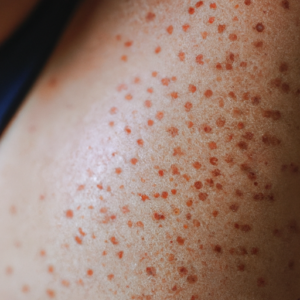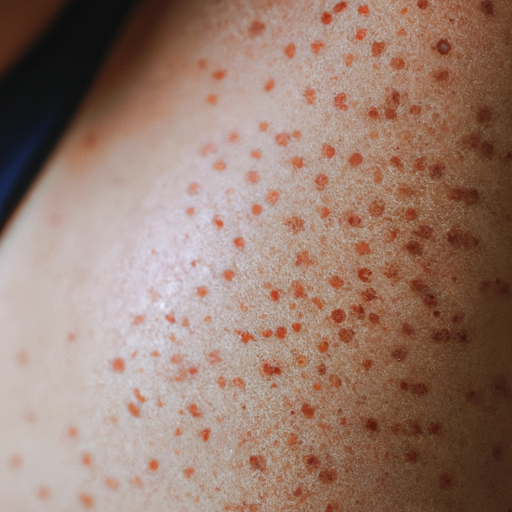Hey there! Let’s talk about Lentigo
Alright folks, let’s start off with the basics. Lentigo is a type of skin spot that is commonly referred to as a freckle or age spot. Basically, it’s a spot on the skin that is darker in color than the surrounding skin. These spots are usually caused by too much sun exposure or hormonal changes.
So, what exactly does a lentigo look like? Great question! Lentigos are dark spots or patches on your skin that range in color from light brown to black. They are usually round, flat, and have well-defined edges. Sometimes, they can also appear slightly raised or even have a darker color in the center than toward the edges.
According to Brightside Beauty, “they are similar in appearance to age spots and can often be found on areas of the body exposed to the sun, such as the face, neck, hands, shoulders, and upper back. They can grow to be anywhere from a few millimeters to a few centimeters in diameter.”
It’s important to note that lentigos are not usually painful, but they can be unsightly and may be a cause for concern if they are discolored or irregular in shape.
Ugh, Why Did I Get That? The Causes of Lentigo
So, you noticed a lentigo on your skin and the first thing you ask is, “Why me?”
Well, lentigos are caused by damage to the skin due to UV exposure. Whether it’s from the sun or tanning beds, the melanocytes in your skin start producing more melanin to protect your skin from further damage. This excess melanin, in turn, causes the brown or black spots associated with lentigo.

But, not all lentigos are from UV exposure. Some people develop them due to genetics. If you have a family history of lentigos or other types of skin discoloration, you may be more likely to develop them too.
In addition to UV exposure and genetics, there are other risk factors for developing lentigos. Hormonal changes, such as those during pregnancy or menopause, can cause lentigos to appear. Certain medications, such as birth control pills or hormone replacement therapy, can also increase your risk.
Finally, age is a risk factor as well. As you get older, your skin is more susceptible to damage from the sun and other environmental factors. This damage can lead to the formation of lentigos.
So, while you may be feeling frustrated about your lentigo, rest assured that it’s a common occurrence. Just remember to protect your skin from further damage by wearing sunscreen and protective clothing, and always seek the advice of a dermatologist if you’re concerned.
Risk Factors for Developing Lentigo (and not for others)
Well, let me tell you, folks: some of us are more likely to develop lentigo than others. It’s just the way it is. Now, before you start worrying or feeling down in the dumps about it, let’s talk about what those risk factors actually are.
First off, fair-skinned folks like myself may have a higher risk due to our skin’s sensitivity to UV radiation. That’s right, the sun’s rays can wreak havoc on our skin and increase the likelihood of developing lentigo.
Age is another big factor. As we get older, our skin has been exposed to decades of sun, pollution, and other environmental factors that can damage it. This damage can lead to the development of lentigo.
If you’ve got a family history of lentigo, then you may be at a greater risk. It’s not entirely clear why this is, but genetics probably plays a role.
Finally, if you work or spend a lot of time outdoors, especially in sunny areas, then you may be at a higher risk for developing lentigo. So, if you’re a lifeguard, farmer, or just love to hike in the mountains, make sure to take some extra precautions to protect your skin.
Now, I don’t want you to feel like you’re doomed to develop lentigo just because of these risk factors. There are definitely things you can do to lower your risk and prevent it from happening.
Get Checked and Treated
As someone with a lentigo, it is essential to get a proper diagnosis from a dermatologist or a skin care specialist. They can evaluate your skin and may suggest a biopsy for confirmation.
If the lentigo is found to be benign, the good news is that it won’t require treatment. However, if you want it removed for cosmetic reasons, there are several treatment options available to you.
One option is to have it removed through a surgical procedure called excision. The doctor will use a scalpel to cut out the lesion and stitch the skin back together. This type of procedure is done under local anesthesia in the doctor’s office, and you can typically return to your normal activities in a few days.
Another option for removal is laser therapy. This procedure involves using a laser to target the pigmented cells and destroy them. The number of sessions required depends on the size and depth of the lentigo.
Cryotherapy is another treatment option where the lentigo is frozen with liquid nitrogen. This is done under local anesthesia, and the area may scab and heal on its own over time.
Finally, topical treatments like hydroquinone and retinoids may be recommended to fade the color and improve the texture of the lesion.
Remember, regular skin checks are crucial to detect any changes in the lentigo or any new lesions that may appear. Talk to your dermatologist about your risk factors and the best plan of action for monitoring and caring for your skin.
Prevention & Outlook
When it comes to preventing lentigo, there are a few things you can do to minimize your risk. Firstly, avoid excessive sun exposure. This means staying indoors during peak hours and wearing protective clothing when outdoors. Sunscreen is also vital to preventing lentigo, so make sure to apply it regularly and reapply every few hours. You can also wear a hat and sunglasses to further protect yourself.
If you already have lentigo, it’s essential to get it treated right away. Depending on the type of lentigo you have, your doctor may recommend a range of treatments, including cryotherapy, laser therapy, or chemical peels. In most cases, these treatments are effective in removing the blemish quickly and painlessly.
It’s also crucial to keep an eye on your skin and check for changes. If you notice any new dark spots or moles, make sure to get them checked out by a dermatologist. Early detection is key to treating more serious conditions like melanoma.
In terms of outlook, the prognosis for lentigo is generally good. With proper treatment and preventative measures, most people can successfully manage the condition without significant complications. However, if left untreated, lentigo may develop into a more serious condition, so it’s important to take action as soon as possible.
In conclusion, the best way to prevent and manage lentigo is to protect your skin from excessive sun exposure, get any blemishes checked out by a dermatologist, and seek treatment immediately if necessary. By taking these steps, you can ensure that your skin stays healthy and beautiful for years to come.
Conclusion: So What Does It All Mean?
Well, after all that talk about lentigo, you might be wondering what it means for you. First of all, if you notice any new or changing spots on your skin, it’s always a good idea to get them checked out by a dermatologist. While most lentigines are harmless, it’s always better to be safe than sorry when it comes to your health.
In terms of prevention, the best thing you can do is protect your skin from the sun’s harmful rays. This means wearing sunscreen, avoiding tanning beds, and seeking shade during the hottest parts of the day. You should also be vigilant about any changes to your skin and report them to your doctor promptly.
Overall, lentigo is a common skin condition that can be managed with early detection and proper care. While it may not be the most exciting topic, it’s important to stay informed about your health and take proactive steps to protect yourself. So next time you notice a new spot on your skin, don’t ignore it – get it checked out and take control of your health!
